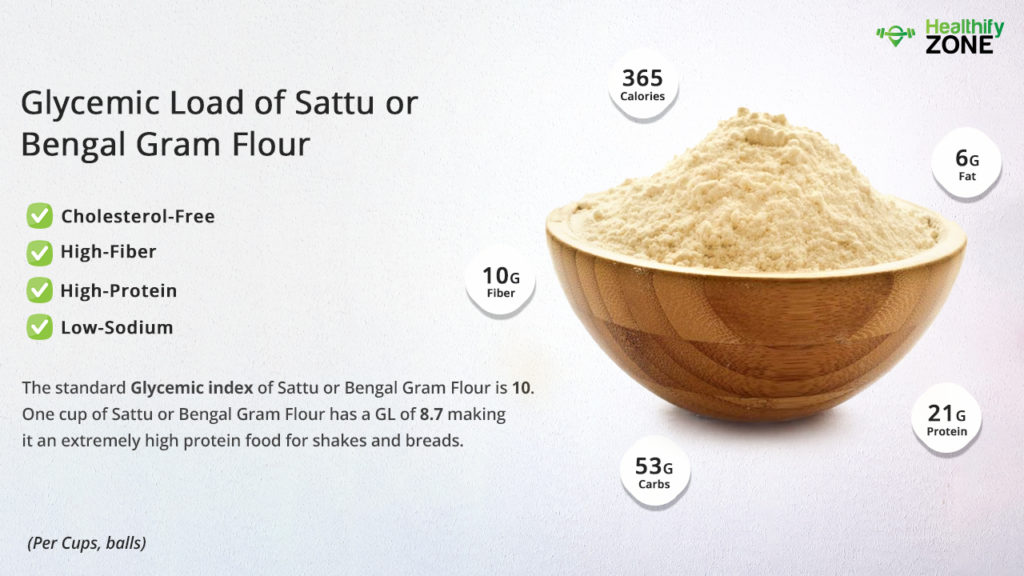Glycemic Load is a classification of food that has carbs and measures how drastically the same causes one’s blood sugar levels to rise. The Glycemic Index assigns a score to the food based on how it makes your blood sugar rise. It helps find alternative sources of nutrients according to the blood glucose levels. Glucose has a higher blood glucose response in comparison to fructose.
Sattu is made using roasted black chana, some lemon juice, and some cumin powder. It is very high in protein and is an excellent summer coolant. It is one of the best remedies for heat and can be consumed in a variety of ways. However, the most popular way is ‘sherbet. It is quite an underrated natural protein drink that has been a favorite in the summertime because of its cooling properties. According to the International GI Tables, it has a GI of 10, which is quite low..’

Sattu is made by roasting and grinding black chana, and it comprises healthy nutrients like
- Protein
- Fiber
- Calcium
- Manganese
- Magnesium
- Iron
How to Calculate Glycemic Load of Sattu or Bengal Gram Flour?
The standard Glycemic index of sattu is 10. The high glycemic index of the foods helps in reducing the risks related to cardiovascular diseases. If we want to talk about diet, the key to prevent diabetes or any chronic illness is to distribute the carbohydrate consumption content throughout the day and manage the sugar levels in the body correctly— owing to high portions of carbs; you can have a satta drink just before hitting the gym.
The Formula/Procedure For Calculation of Glycemic Index of the Sattu :
GL = GI * carbs / 100
where
- GL – glycemic load;
- GI – glycemic index;
- and carbs – the amount of carbohydrates in the portion.

| SL.NO | SATTU BY WEIGHT IN (g) | GLYCEMIC LOAD |
| 1. | 100 g of Sattu | 5.8 (low) |
| 2. | 250 g of Sattu | 14.5 (medium) |
| 3. | 500 g of Sattu | 29 (high) |
| 4. | 1 Kg of Sattu | 58 (high) |
| 5. | 1 Cup of Sattu (150 g) | 8.7 (low) |
Is Sattu / Bengal Gram Flour Safe to Consume If You Have Diabetes?
Sattu is a great drink for diabetics. It has high fiber content and has a very low GI, which means that it would not cause a sudden elevation in blood sugar levels. One of the challenges for a diabetic patient is to manage and maintain blood sugar levels. Sattu helps with that. It helps keep a check on blood sugar levels. Also, it helps in maintaining high cholesterol levels.
Can I Eat Sattu / Bengal Gram Flour During a Fat-Loss Diet?
Sattu is an excellent addition to your fat-loss diet. You can consume it as sherbet, post-workouts, and it will make for an excellent all-natural protein shake.

- A 250g serving of sattu has a GL of 14.5 which is in the permissible levels.
- Sattu is high in protein, which helps you feel fuller for longer and weight loss.
Can I Eat Sattu / Bengal Gram Flour During a Low-Carbohydrate Diet?
You can be eating sattu during a low-carbohydrate diet. However, it is important to consume it in moderation. We suggest that you do not consume more than 200 g.
Is Sattu High in Sugar?
A 100 g of sattu serving has 4 g of sugar and 27 g of carbohydrates. It is very low in sugar but has a considerable amount of carbs present in it, which is why one must be cautious. However, it is very nutrient-rich and must be a part of your healthy diet.